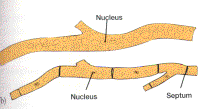

THE FUNGI
Additional Reading: Look at the pictures and figures of the Fungi in Tortora, chapter 12.
According to Sagan and Margulis in their book Garden of Microbial Delights, modern marketing and television advertising campaigns teach that "microbes are universally dangerous, disgusting and disease causing." If you listen to the TV ads, fungi in particular will "ruin your bread, eat your house, rot your crotch and make your feet smell."
Yet, according to these authors, "the fungi have composed a symphony of evolutionary delights which includes champagne, wine and beer; the mind altering drugs psilocybin and LSD; the raising and the texturing of bread; the ripening of brie, camembert and other cheeses; the flavor of shoyu andmiso; and the treasure of many types of mushrooms."
YEASTS are unicellular spherical fungi which reproduce asexually by budding. This is not fission since the daughter cell is smaller than the mother cell. Some yeasts, like Saccharomyces cerevisiae, are capable of sexual reproduction.
Saccharomyces cerevisiae is the organism responsible for making wine, beer and leavening bread. These products are made through FERMENTATION. In this case, fermentation is a process whereby energy is extracted from sugar and carbon dioxide and alcohol are produced as waste products.
There are some pathogenic yeasts. These include:
Candida albicans (Monilia) - an opportunistic commensal which can cause vulvovaginitis and thrush.Cryptococcus neoformans - a yeast widely distributed in the soil and common in bird droppings. This organism can cause respiratory infections which then have a tendency to spread to the central nervous system and cause MENINGITIS.
Pneumocystis carinii - this organism is widely dispersed in animals and we apparently are exposed to itrepeatedly throughout life. This organism of low virulence is capable of causing life threatening pneumonia in individuals with AIDS. This is a classic opportunist.
MOLDS are filamentous fungi which can reproduce by SPORES and also by pieces broken off of their filaments. Each of these filaments is called a HYPHA (-AE) and these hyphae can have SEPTA or they can be ASEPTATE. Hyphae without septa are also called COENOCYTIC. The first picture below shows the difference between septate and aseptate hypha. The second picture is a description of what the septal crosswall looks like.


As a mold develops, the hyphae accumulate into a visible mass which is called a MYCELIUM. The mycelium is also known as the "body" or THALLUS of the mold. In some molds the lower hyphae will form small root-like structures called RHIZOIDS which help anchor the hyphae to the food source.
In this picture of the common bread mold, Rhizopus, the rhizoids
are the little "root-like" structures coming off of the bottom of the
hypha. 
Specialized hyphae known as AERIAL HYPHAE develop as the mold colony matures and FRUITING HEADS bearing asexual SPORES develop on these. CONIDIOSPORES form on the outside of the fruiting head which in this case is called a CONIDIUM. SPORANGIOSPORES develop within a fruiting structure known as a SPORANGIUM. Some molds are capable of mating. The fruiting structure formed after mating is called an ASCUS and the spores inside are called ASCOSPORES. For a description of these structures please see the diagram below.:

There are a number of MYCOSES caused by molds. These mycoses can be either SYSTEMIC or SUPERFICIAL.
Most of the superficial mycoses are diseases of the skin known by colorful names like ATHLETE'S FOOT, RINGWORM AND JOCK ITCH. These diseases are caused by a group of molds known as the DERMATOPHYTES.
The systemic mycoses can be debilitating and life threatening. The agent of coccidioidomycoses or VALLEY FEVER is widespread in the soils of the southwest US. and people become infected by breathing dust which contains the spores. This route of infection was demonstrated again after the Northridge earthquake several years ago in Southern California which kicked up much dust and caused a rise in infections.